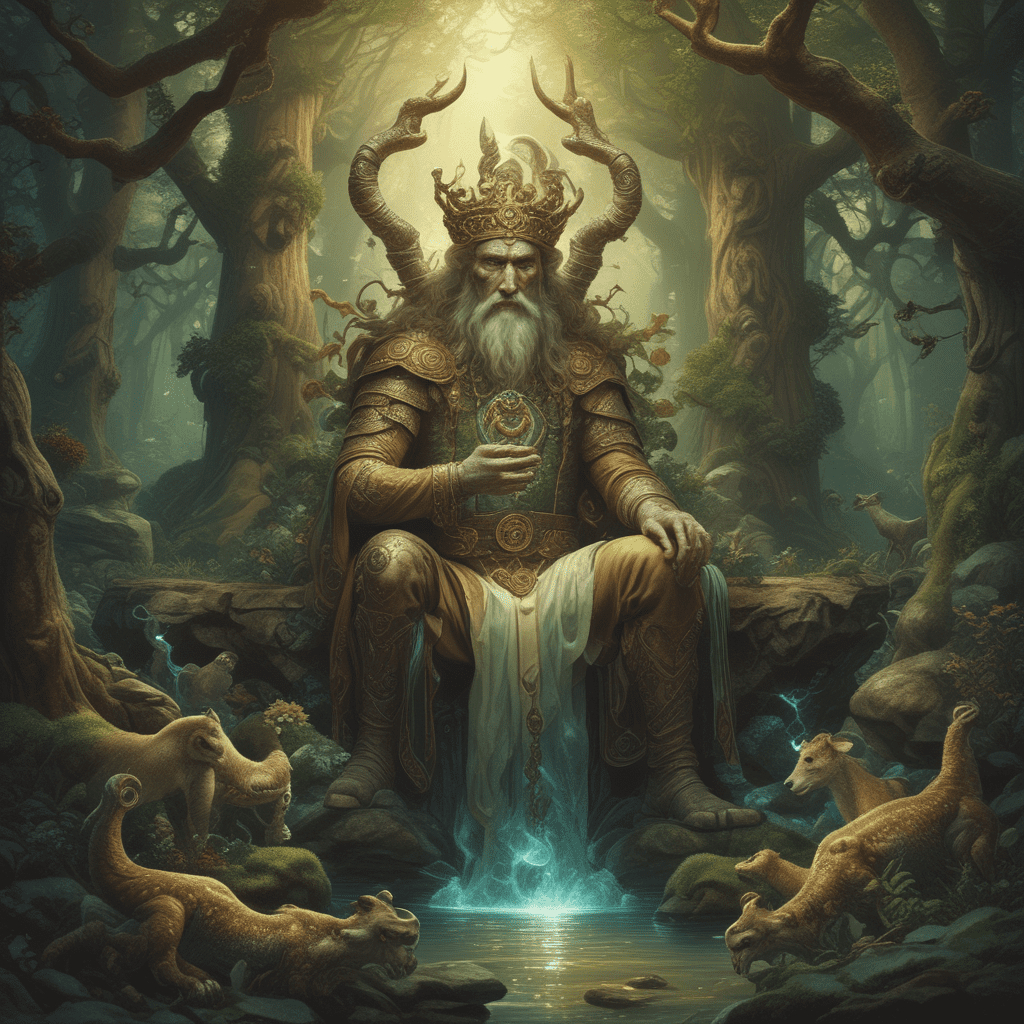The Mythical Labyrinth: Navigating the Stories of Creation
I. Introduction
The labyrinth has captivated human imagination for centuries, serving as a powerful symbol across various cultures and mythologies. A labyrinth is often defined as a complex network of paths or passages, making it a fitting metaphor for the intricate journey of life itself. In the realm of mythology, labyrinths represent not just physical spaces, but also the psychological and spiritual challenges faced by individuals.
This article aims to explore creation myths from different cultures, revealing how the concept of the labyrinth intersects with these narratives. By examining the labyrinth as a symbol of creation, we can gain insights into the human experience and the universal themes that bind us together.
II. The Concept of the Labyrinth in Mythology
A. Historical Origins of Labyrinth Symbols
The origins of labyrinth symbols can be traced back to ancient civilizations, where they were often associated with sacred spaces and spiritual journeys. The most famous labyrinth is perhaps the one in Crete, designed by Daedalus to contain the Minotaur. This mythological representation reflects deeper themes of life’s complexities and the search for meaning.
B. The Labyrinth as a Metaphor for Life’s Journey
The labyrinth serves as a metaphor for the twists and turns that individuals encounter throughout their lives. Just as one navigates a labyrinth, people often must make choices, confront challenges, and seek understanding in their personal journeys. This metaphor resonates with many, illustrating the interplay of confusion and clarity in the quest for purpose.
C. Labyrinths in Ancient Civilizations: An Overview
- Ancient Greece: The story of the Minotaur and the labyrinth designed by Daedalus.
- Egypt: Labyrinths were symbols of the underworld and the journey to the afterlife.
- Mesopotamia: Labyrinthine designs in temples signified the path to the divine.
III. Creation Myths: A Cross-Cultural Perspective
A. Overview of Creation Myths in Different Cultures
Creation myths vary widely across cultures, often reflecting the values and beliefs of the societies from which they originate. Common elements include the emergence of the universe from chaos, the role of deities, and the establishment of order from disorder. These narratives often include a journey or transformation, echoing the labyrinthine theme.
B. Comparative Analysis: Similarities and Differences
While creation myths differ in details, many share fundamental similarities, such as:
- Creation from chaos or nothingness.
- The involvement of a supreme being or cosmic force.
- The establishment of life and order.
Differences often lie in the cultural context, the characteristics of the deities involved, and the specific processes of creation described.
C. The Role of the Labyrinth in Various Creation Myths
In some cultures, labyrinths symbolize the journey of creation itself. For instance, in Hindu mythology, the concept of the cosmic ocean serves as a metaphor for the chaotic state of the universe before creation emerges. The labyrinth can be seen as a representation of the complex paths leading to enlightenment and understanding of the universe.
IV. The Greek Myth of the Labyrinth and the Minotaur
A. The Story of Theseus and the Minotaur
The Greek myth of Theseus and the Minotaur is one of the most iconic stories involving a labyrinth. According to the myth, King Minos of Crete imprisoned the Minotaur, a beast that was half-man, half-bull, in a labyrinth. To defeat the creature, Theseus volunteered to enter the labyrinth, armed with a sword and a ball of thread provided by Ariadne, Minos’ daughter. This thread allowed him to navigate the labyrinth and ultimately slay the Minotaur.
B. Symbolism of the Labyrinth in Greek Mythology
The labyrinth symbolizes both the physical and psychological challenges that individuals face. It represents the struggle against one’s fears and the quest for knowledge and clarity. The journey through the labyrinth is a rite of passage that leads to personal transformation.
C. Themes of Sacrifice and Redemption in the Tale
The story is rich with themes of sacrifice and redemption. Theseus’ journey into the labyrinth signifies a hero’s quest, where he sacrifices his safety to confront the Minotaur, a metaphor for facing one’s inner demons. His eventual triumph represents the possibility of redemption and enlightenment through struggle.
V. The Labyrinth in Eastern Philosophies and Creation Stories
A. Hindu Creation Myths: The Cosmic Ocean and the Labyrinthine Universe
In Hindu creation myths, the universe is often described as emerging from the cosmic ocean, a chaotic expanse where creation unfolds. This concept can be likened to a labyrinth, where the paths of creation are intricate and convoluted, leading to the eventual manifestation of the cosmos.
B. The Labyrinth as a Symbol of Enlightenment in Buddhism
In Buddhism, the labyrinth represents the journey toward enlightenment. The paths within the labyrinth symbolize the various stages of spiritual growth and the challenges one must overcome to achieve Nirvana. Each turn in the labyrinth reflects the complexities of life and the pursuit of inner peace.
C. Comparative Insights on the Nature of Creation
Both Hindu and Buddhist philosophies emphasize the cyclical nature of existence, where creation and dissolution are intertwined. The labyrinth serves as a powerful symbol of this cycle, highlighting the continuous journey of life, death, and rebirth.
VI. The Labyrinth and Indigenous Creation Myths
A. Native American Perspectives on Creation and the Journey
Indigenous creation stories often emphasize the interconnectedness of all beings and the importance of the natural world. The labyrinth is a recurring motif in some Native American myths, representing the journey of the people as they navigate their relationship with the earth and the spirit world.
B. The Role of Nature in Indigenous Labyrinths
In many indigenous cultures, labyrinths are created as sacred spaces for reflection and spiritual connection. These labyrinths are often found in natural settings, emphasizing the relationship between the earth and the spiritual realm.
C. Spiritual Significance of the Labyrinth in Indigenous Cultures
The labyrinth serves as a spiritual tool, guiding individuals on their personal journeys. It encourages introspection and a deeper understanding of one’s place in the world, fostering a sense of community and connection to the land.
VII. The Labyrinth in Modern Literature and Art
A. The Influence of Mythical Labyrinths on Contemporary Writers
Modern literature continues to draw inspiration from the concept of the labyrinth. Authors like Jorge Luis Borges and Umberto Eco utilize labyrinthine structures to explore themes of identity, knowledge, and the nature of reality. Their works reflect the complexities of the human experience, echoing the ancient symbolism of the labyrinth.
B. Artistic Representations of Labyrinths in Modern Culture
Artists across various media have incorporated labyrinths into their works, often using them to symbolize the intricate nature of life and the search for truth. From visual art to performance, the labyrinth remains a potent symbol in contemporary culture.
C. The Labyrinth as a Narrative Device in Storytelling
The labyrinth serves as a narrative device that allows for exploration of character development and plot complexity. It provides a framework for characters to confront their fears and desires, ultimately leading to transformation and self-discovery.
VIII. Psychological Interpretations of the Labyrinth
A. Carl Jung and the Collective Unconscious
Psychoanalyst Carl Jung viewed the labyrinth as a representation of the collective unconscious, where archetypes and universal symbols reside. The labyrinth embodies the journey into the self, where individuals confront their inner conflicts and seek integration of the psyche.
B. The Labyrinth as a Representation of the Human Psyche
The labyrinth can also represent the complexities of the human mind, with its winding paths symbolizing the myriad thoughts, emotions, and experiences that shape our identities. Navigating this mental labyrinth can lead to greater understanding and self-awareness.
C. Navigating Personal Labyrinths: Modern Psychological Perspectives
Modern psychology often emphasizes the importance of navigating personal labyrinths as a means of growth and healing. Therapists encourage individuals to explore their inner labyrinths, confronting fears and traumas to achieve personal transformation.
IX. The Labyrinth as a Tool for Spiritual and Personal Growth
A. Walking the Labyrinth: A Spiritual Practice
Walking a labyrinth is a meditative practice that encourages introspection and spiritual connection. Many contemporary spiritual communities use labyrinths as a tool for reflection, allowing individuals to engage with their inner selves and



